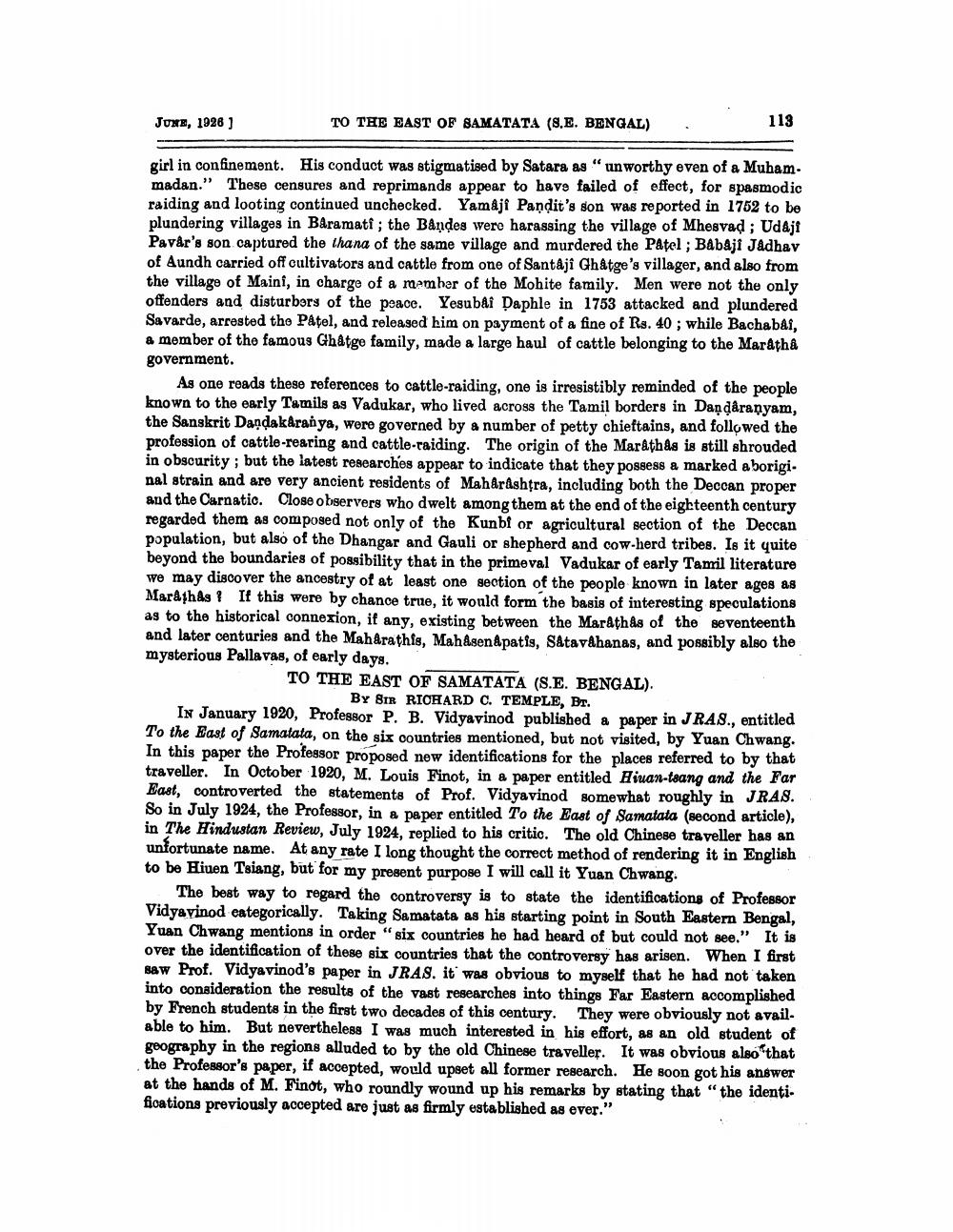________________
TO THE EAST OF SAMATATA (8.E. BENGAL)
girl in confinement. His conduct was stigmatised by Satara as "unworthy even of a Muham. madan." These censures and reprimands appear to have failed of effect, for spasmodic raiding and looting continued unchecked. Yamâjî Pandit's son was reported in 1752 to be plundering villages in Baramatî; the Bândes were harassing the village of Mhesvad; Udâjî Pavar's son captured the thana of the same village and murdered the Pâtel; Babaji Jadhav of Aundh carried off cultivators and cattle from one of Santaji Ghatge's villager, and also from the village of Maini, in charge of a member of the Mohite family. Men were not the only offenders and disturbers of the peace. Yesubai Daphle in 1753 attacked and plundered Savarde, arrested the Patel, and released him on payment of a fine of Rs. 40; while Bachabâî, a member of the famous Ghatge family, made a large haul of cattle belonging to the Marathâ government.
JUNE, 1926]
113
As one reads these references to cattle-raiding, one is irresistibly reminded of the people known to the early Tamils as Vadukar, who lived across the Tamil borders in Dandaranyam, the Sanskrit Daṇḍakaranya, were governed by a number of petty chieftains, and followed the profession of cattle-rearing and cattle-raiding. The origin of the Marathas is still shrouded in obscurity; but the latest researches appear to indicate that they possess a marked aborigi. nal strain and are very ancient residents of Maharashtra, including both the Deccan proper and the Carnatic. Close observers who dwelt among them at the end of the eighteenth century regarded them as composed not only of the Kunbf or agricultural section of the Deccan population, but also of the Dhangar and Gauli or shepherd and cow-herd tribes. Is it quite beyond the boundaries of possibility that in the primeval Vadukar of early Tamil literature we may discover the ancestry of at least one section of the people known in later ages as Marathas? If this were by chance true, it would form the basis of interesting speculations as to the historical connexion, if any, existing between the Marathas of the seventeenth and later centuries and the Maharathis, Mahasen&patis, Satavahanas, and possibly also the mysterious Pallavas, of early days.
TO THE EAST OF SAMATATA (S.E. BENGAL). BY SIR RICHARD C. TEMPLE, BT.
IN January 1920, Professor P. B. Vidyavinod published a paper in JRAS., entitled To the East of Samatata, on the six countries mentioned, but not visited, by Yuan Chwang. In this paper the Professor proposed new identifications for the places referred to by that traveller. In October 1920, M. Louis Finot, in a paper entitled Hiuan-teang and the Far East, controverted the statements of Prof. Vidyavinod somewhat roughly in JRAS. So in July 1924, the Professor, in a paper entitled To the East of Samatata (second article), in The Hindustan Review, July 1924, replied to his critic. The old Chinese traveller has an unfortunate name. At any rate I long thought the correct method of rendering it in English to be Hiuen Tsiang, but for my present purpose I will call it Yuan Chwang.
The best way to regard the controversy is to state the identifications of Professor Vidyavinod categorically. Taking Samatata as his starting point in South Eastern Bengal, Yuan Chwang mentions in order "six countries he had heard of but could not see." It is over the identification of these six countries that the controversy has arisen. When I first saw Prof. Vidyavinod's paper in JRAS. it was obvious to myself that he had not taken into consideration the results of the vast researches into things Far Eastern accomplished by French students in the first two decades of this century. They were obviously not available to him. But nevertheless I was much interested in his effort, as an old student of geography in the regions alluded to by the old Chinese traveller. It was obvious also that the Professor's paper, if accepted, would upset all former research. He soon got his answer at the hands of M. Finot, who roundly wound up his remarks by stating that "the identifications previously accepted are just as firmly established as ever."




